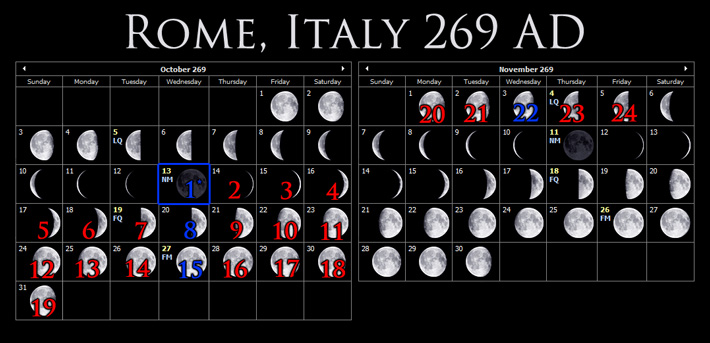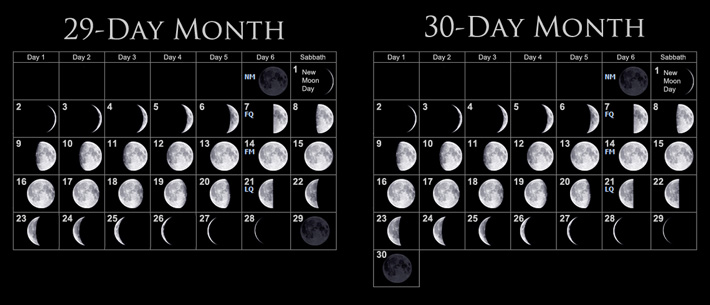The Historical Argument
(II) The Historical Argument
Sepulchral
Inscription (269 A.D.)
A record of the Christian transition to pagan calendation has been preserved in various sepulchral inscriptions. One of the oldest dated Christian sepulchral inscriptions to be discovered in Rome refers to dies Veneris (day of Venus). What sets this particular inscription apart is that it lists both the Julian date and the luni-solar date. Dated A.D. 269, it states:
In the consulship of Claudius and Paternus, on the Nones of November, on the day of Venus, and on the 24th day of the lunar month, Leuces placed [this memorial] to her very dear daughter Severa, and to Thy Holy Spirit. She died [at the age] of 55 years, and 11 months [and] 10 days. (E. Dichl, Inscriptiones Latinæ Christianæ Veteres, Vol. 2, p. 193, #3391. See also, J. B. de Rossi, Inscriptiones Christianæ Urbis Romæ, Vol. 1, part 1, p. 18, #11.)
The “Nones” of November is November 5 which fell that year on the day of Venus, Friday. In that lunation, this corresponded with the 24th day of the lunar month, or “Second Day” on the Biblical week. Examining the dates here with astronomy software, we find that New Moon Day (the first day of the lunar month) was reckoned as the day after conjunction.

*Please Note: Conjunction actually happened in Rome at 2:05 am (October 13), well before dawn.
This is why the day of Conjunction appears to be day 1 and not day 29 or 30 of the previous month (lunation).
The Writings of Philo (20 B.C.–50 A.D.)
Philo (a Hellenistic Jewish Philosopher from Alexandria) lived before, during, and after our Saviour's earthly ministry. It stands to reason, then, that he would have espoused a correct understanding of Biblical calendation.
 |
|
Philo of Alexandria (20 B.C.–50 A.D.), |
In the below quotation, Philo says that the New Moon festival takes place when the moon begins to illuminate. As previously stated, the moon becomes illuminated immediately after conjunction. We cannot see it, though, until the sun sets because the moon is obscured by the greater light of the sun. The fact that we cannot see the moon immediately after conjunction, however, does not negate the fact that it has already began a new revolution and is again re-illuminating. Often, the first visible crescent will be seen on the evening of New Moon Day, displaying to the viewer her new light.
“Following the order which we have adopted, we proceed to speak of the third festival, that of the new moon. First of all, because it is the beginning of the month, and the beginning, whether of number or of time, is honorable. Secondly, because at this time there is nothing in the whole of heaven destitute of light. Thirdly, because at that period the more powerful and important body gives a portion of necessary assistance to the less important and weaker body; for, at the time of the new moon, the sun begins to illuminate the moon with a light which is visible to the outward senses, and then she displays her own beauty to the beholders…" (Philo, Special Laws II, Section XXVI (140-142))
In the following quotations, Philo plainly states that New Moon Day follows conjunction and that months are reckoned from conjunction to conjunction.
"The third [festival] is that which comes after the conjunction, which happens on the day of the new moon in each month." (Philo, Special Laws II, Section XI (41))
"This is the New Moon, or beginning of the lunar month, namely the period between one conjunction and the next, the length of which has been accurately calculated in the astronomical schools." (Philo, Special Laws II, Section XXVI (140)) Note: The Hendrickson Publishers edition (1993) of C. D. Jonge’s 1854 translation does not have the same information that the Colson translation gives. The indications are that the conjunctions were determinative in deciding the first of the month.
Philo's statements below indicate that the moon completes its perfect configurations (i.e. waxing half-moon, full moon, waning half-moon, conjunction) at the end of each week. When reckoning the dawn after conjunction as the commencement of New Moon Day, this is most often the case.
“Again, the periodical changes of the moon, take place according to the number seven, that star having the greatest sympathy with the things on earth. And the changes which the moon works in the air, it perfects chiefly in accordance with its own configurations on each seventh day. At all events, all mortal things, as I have said before, drawing their more divine nature from the heaven, are moved in a manner which tends to their preservation in accordance with this number seven. … Accordingly, on the seventh day, Elohim caused to rest from all his works which he had made.” (Philo, Allegorical Interpretation, 1, Section IV (8-9), Section VI (16))
“…there is one principle of reason by which the moon waxes and wanes in equal intervals, both as it increases and diminishes in illumination; the seven lambs because it receives the perfect shapes in periods of seven days—the half-moon in the first seven day period after its conjunction with the sun, full moon in the second; and when it makes its return again, the first is to half-moon, then it ceases at its conjunction with the sun.” (Philo, Special Laws I, (178))

Please Note: This is an
ideal representation of the Lunar Month when reckoning New Moon Day as
the Day After Conjunction. Because the Moon can achieve the perfect
Quarter, Full, and Conjunction phases at any time during a 24-hour
period, and since most (if not all) programs/calendars use a midnight to
midnight reckoning of a date, you will sometimes see the perfect phases
shown a day earlier or a day later, making them not always line up
exactly. You will need to check the time of Conjunction for your
specific area.
Below, our interpretation of Philo's previous statements is confirmed. Here, Philo states that the moon should be full at the end of the second week (i.e. the 15th day of the lunar month). Note: When reckoning the day after conjunction as New Moon Day, the moon will full on the 14th or 15th of the month.
“For it is said in the Scripture: On the tenth day of this month let each of them take a sheep according to his house; in order that from the tenth, there may be consecrated to the tenth, that is to [Elohim], the sacrifices which have been preserved in the soul, which is illuminated in two portions out of the three, until it is entirely changed in every part, and becomes a heavenly brilliancy like a full moon, at the height of its increase at the end of the second week . . .” (On Mating with the Preliminary Studies, Section XIX, (106))
“And this feast is begun on the fifteenth day of the month, in the middle of the month, on the day on which the moon is full of light, in consequence on the providence of Elohim taking care that there shall be no darkness on that day.” (Philo, Special Laws II, The Fifth Festival, Section XXVIII (155))
This is in perfect harmony with Psalm 81:3. (See Lesson 2, "The Biblical Argument".)









